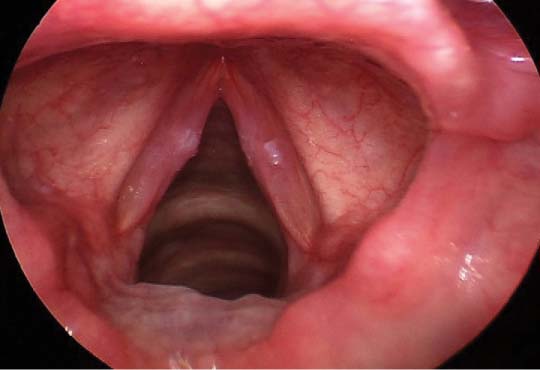54 A 55-year-old man complains of “chronic sinus drainage” for many years. He also complains of a need to clear his throat often to clear thick phlegm. On further questioning, he reports periodic soreness of his throat, intermittent hoarseness, and the sensation of a lump in the throat. He denies hemoptysis, rhinorrhea, and weight loss. He currently smokes one pack of cigarettes per day and has done so for 35 years. On physical examination, he is an over-weight male with a mildly raspy voice. His tonsils are atrophic. Flexible nasolaryngoscopy reveals moderately edematous vocal folds, edema and erythema of the arytenoid mucosa, and thickening at the posterior commis-sure (Fig. 54.1). The rest of the head and neck examination is unremarkable. 1. The chronic nature of this patient’s complaints points to an insidious process. Hoarseness, mucus accumulation in the throat (postnasal drip), sore throat, and lump in the throat sensation (globus pharyngeus) are vague symptoms frequently associated with laryngopharyngeal reflux (LPR).Additional symptoms of LPR include regurgitation of acid contents into the throat causing choking, burning and laryngospasm, asthma, cervical dysphagia, excess salivation, and repeated swallowing. Chronic non-productive cough and halitosis are frequent complaints. Otalgia may be described and is thought to be mediated by the vagus nerve. Fig. 54.1 Video stroboscopic view of the endolarynx reveals mid-to-moderate edema of the true vocal folds with erythema and edema of the arytenoid mucosa. Mild thickening (pachyderma) of the posterior commissure is also seen. 2. On laryngoscopy, the physical presentations of LPR are protean and consist of the following: A. Erythema and edema of the arytenoid B. Pachydermia of the posterior commissure C. Reinke edema with or without significant erythema D. Diffuse erythema with friable mucosa of the supraglottis E. Vocal process granulomata F. “Cobblestoning” of the pharyngeal mucosa G. Vocal cord polyps with any of the above findings H. Formation of contact ulcers I. Pseudosulcus of the vocal folds J. Glottis or subglottic stenosis K. Paradoxical vocal fold movement L. Laryngeal dysplasia or cancer 3. Classic symptoms of gastroesophageal reflux disease (GERD) include heartburn, a feeling of regurgitation, excessive belching, or intermittent substernal and epigastric chest pain. Only 20% of patients with LPR will complain of heartburn. 4. The same conditions that predispose to GERD also cause LPR. These conditions include obesity, straining, lying in a supine position, prolonged intubation, nasogastric tube placement, and foods that increase acid production such as fats, chocolate, carminatives (peppermint, spearmint, cinnamon, garlic, and onions), milk, alcoholic beverages, orange juice, and tomato juice. 5. Medications that have been associated with GERD include antidepressants, progesterone, β-blockers, calcium channel blockers, α-blockers, valium, and morphine. Nicotine and caffeine have a similar effect. These medications, and many of the abovementioned foods, induce reflux by reducing lower esophageal sphincter tone. 6. The complaint of globus raises concerns about pathology affecting the upper esophageal sphincter (cricopharyngeus). Globus pharyngeus is described as a choking sensation or lump in the throat. Edema of the mucosa in this area can present in this manner. Zenker diverticulum can also present with this complaint. In an immunocom-promised patient, esophageal candidiasis should be considered. 7.
Laryngopharyngeal Reflux
History
Differential Diagnosis—Key Points
![]()
Stay updated, free articles. Join our Telegram channel

Full access? Get Clinical Tree



